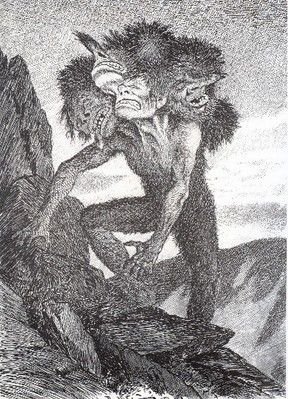"[An]..explanation for the troll myth, is that the trolls represent the remains of the forefather-cult which was ubiquitous in Scandinavia until the introduction of Christianity in the 10th and 11th centuries. In this cult the forefathers were worshipped in sacred groves, by altars or by gravemounds. One of the customs associated with this practice was to sit on top of a gravemound at night, possibly in order to make contact with the deceased.
With the introduction of Christianity however, the religious elite sought to demonize the pagan cult, and declared the forefathers as evil. For instance, according to Magnus Håkonsen's laws from 1276 it is illegal to attempt to wake the "mound-dwellers". It is in these laws that the word troll appears for the first time, denoting something heathen and generally unfavourable."







While the exact origin(s) of trolls in Scandinavian folklore might be complex and somewhat contentious, Mme Balzamo1 suggests that the illustrative forms we have all encountered probably had their precursors in the 16th century sociocartographic works of Olaus Magnus.
Magnus was responsible for the famous 1539 Scandinavian map, 'Carta Marina' [5Mb complete work or sectioned jpeg images] and released the massive 'Historia de Gentibus Septentrionalibus' in 1555, which purported to outline the history of the Nordic peoples. Both included illustrations of monsters and mythical creatures.
It may be coincidental but 'Carta Marina' was 'lost' for 3 centuries, only to be rediscovered in 1882, around the time when troll illustrations began to appear in popular literature.
Romantic fairytale illustrators Theodor Severin Kittelsen (i, ii, iii) John Bauer (i, ii, iii) and Elsa Beskow (i, ii, iii) are regarded as the leading artists of the polymorphic troll figure from the late 19th and early 20th centuries. The genre would later be adapted by Tove Jansson for her internationally successful Moomin characters (i, ii, iii).
- 1This post came about by my stumbling across an exhibition website of Bibliothèque Sainte-Geneviève: "Des Trolls, des Ogres et des Géants dans l'Illustration des Contes Populaires Nordiques" - almost all of the above illustrations come from here.
- Subsequently I found the Troll Blog, a comprehensive and interesting site in english with a lot of esoteric imagery.
- The wikipedia article on trolls is fairly extensive. It cites Camilla Asplund Ingemark as a reference: she completed her PhD thesis on trolls (the first Finnish dissertation on the subject) last year. There is a background article on the relationship of trolls and religion by Ingemark here.
No comments:
Post a Comment